The Acoustic Characteristics of Hellenistic Morgantina Theatre in Modern Use
Abstract
:1. Introduction
2. Historical Background of Morgantina
3. Acoustic Measurements
- 2-channel microphone (01 dB-Symphonie).
- Dummy head.
- 31-channel spherical array microphone.
- Prismatic array camera (No. 12 lenses).
- The early decay time (EDT) is related to the early reflections occurring in the first 10 dB decay after the impulse. The integrated Schroder curve suggests that the EDT can be calculated from the reverberation decay curve. The optimal values for the enclosed theatres are between 1.8 s and 2.6 s.
- Reverberation time refers to the time it takes for sound energy to decay by one millionth compared to the initial level of a stationary sound source. The decay range considered in this research study is between −5 dB and −35 dB (T30). The reverberation time is highly dependent on absorption coefficients of the room boundaries other than on the volume of the considered space.
- The clarity index (C80) is based on the ratio between the sound reflections arriving within 80 ms (for music) and the sound energy arriving in the following instants of the soundwave. The optimal value of the clarity index is 0 dB, meaning a perfect balance of early and late reflections, but a tolerance of ±2 dB is given.
- Definition (D50) is another acoustic parameter used for describing the characteristics of a room. The speech definition is targeted between 50% and 100%, while the best range for music is defined between 0% and 50%.
- The speech transmission index (STI) is a parameter for the objective definition of speech intelligibility in a room. The STI parameter ranges from 0 to 1 (0 = bad understanding; 1 = excellent understanding). When the STI is close or at 1, the environment is very suitable for speech understanding. STI aims to objectively quantify the comprehensibility of speech in a specific position in a room, and it is classified in the following ranges: bad < 0.32; poor 0.32–0.45; fair 0.45–0.60; good 0.60–0.75; excellent > 0.75.
- The interaural cross-correlation (IACC) is a binaural acoustic parameter indicating spatial involvement in a certain environment. High values of IACC correspond to a monoaural response, lacking the stereophony and spatial information, while low values of IACC mean a good audio immersion inside the space.
4. Results of Monoaural Acoustic Parameters
5. Results of Binaural Acoustic Parameters and Beamforming Mapping
6. Discussions
7. Conclusions
Author Contributions
Funding
Data Availability Statement
Conflicts of Interest
References
- Izenour, G.C. Theatre Design; McGraw-Hill: New York, NY, USA, 1977. [Google Scholar]
- Wiles, D. Greek Theatre Performance: An Introduction; Cambridge University Press: Cambridge, MA, USA, 2000. [Google Scholar]
- Arnott, P. An Introduction to the Greek Theatre; Springer: Berlin/Heidelberg, Germany, 1991. [Google Scholar]
- Sabine, W.C. Collected Papers on Acoustics; Cambridge Harvard University Press: Cambridge, MA, USA, 1923. [Google Scholar]
- Vitruvio, M.P. De Architectura; Priestley and Weale: London, UK, 1826. [Google Scholar]
- Polychronopoulos, S.; Skarlatos, D.; Kougias, D. The use of resonators in ancient Greek Theatres. In Proceedings of the International Conference “The Acoustics of Ancient Theatres”, Patras, Greece, 18–21 September 2011; HELINA and EAA: Patras, Greece, 2011. [Google Scholar]
- Bellia, A.; Bevilacqua, A. Rediscovering the Intangible Heritage of Past Performative Spaces: Interaction between Acoustics, Performance, and Architecture. Heritage 2023, 6, 319–332. [Google Scholar] [CrossRef]
- Gogos, S. The Ancient Theatre of Dionysus; Militos Emerging Technologies & Services: Athens, Greece, 2006. [Google Scholar]
- McDonald, M.; Walton, M. (Eds.) The Cambridge Companion to Greek and Roman Theatre (Cambridge Companions to Literature); Cambridge University Press: Cambridge, MA, USA, 2007. [Google Scholar] [CrossRef]
- Sear, F. Roman Theatres: An Architectural Study; OUP Oxford: Oxford, UK, 2006. [Google Scholar]
- Barkas, N. The contribution of the stage design to the acoustics of Ancient Greek theatres. Acoustics 2019, 1, 18. [Google Scholar] [CrossRef]
- Sjöqvist, E. Sicily and the Greeks: Studies in the Interrelationship between the Indigenous Populations and the Greek Colonists; University of Michigan Press: Ann Arbor, MI, USA, 1973. [Google Scholar]
- Stillwell, R. Excavationsat Morgantina (Serra Orlando) 1966: Preliminary Report IX. Am. J. Archaeol. 1967, 71, 245–250. [Google Scholar] [CrossRef]
- Morgantina. Available online: https://www.prolocoaidone.it/galleria-2/ (accessed on 19 August 2023).
- Amadasi, G.; Giacomin, P.; Merenda, G.; Cappellini, G.; Di Fisco, G. Studio per l’individuazione di un distretto culturale nella Sicilia Centro-Orientale: Studio Acustico: Caratterizzazione Acustica del Teatro di Morgantina, Regione Sicilia Ass.to Beni Culturali, Centro Progettazione e Restauro. 2003. [Google Scholar]
- ISO 3382; Acoustics—Measurement of Room Acoustic Parameters. International Organization for Standardization: Geneva, Switzerland, 2009.
- Canac, F. L’Acoustique des Theatres Antiques. Ses Enseignements; Editions du Centre National de la Recherché Scientifique: Paris, France, 1967. [Google Scholar]
- Rindel, J.H. Roman theatres and revival of their acoustics in the ERATO Project. Acta Acust. United Acust. 2013, 99, 21–29. [Google Scholar] [CrossRef]
- Girón, S.; Álvarez-Corbacho, Á.; Zamarreño, T. Exploring the acoustics of ancient open-air theatres. Arch. Acoust. 2020, 45, 181–208. [Google Scholar]
- Gade, A.; Angelakis, K. Acoustics of ancient Greek and Roman theatres in use today. In Proceedings of the 4th Joint Meeting of ASA and ASJ, Honolulu, HI, USA, 29 November 2006. [Google Scholar]
- Vassilantonopoulos, S.L.; Mourjopoulos, J.N. A study of ancient Greek and Roman theater acoustics. Acta Acust. United Acust. 2003, 89, 123–136. [Google Scholar]
- Boren, B. Acoustic Simulation of Julius Caesar’s Battlefield Speeches. Acoustics 2019, 1, 3–13. [Google Scholar] [CrossRef]
- Shankland, R.S. Acoustics of Greek theatres. Phys. Today 1973, 26, 30–35. [Google Scholar] [CrossRef]
- Farnetani, A.; Prodi, N.; Pompoli, R. On the acoustics of ancient Greek and Roman theaters. J. Acoust. Soc. Am. 2008, 124, 1557–1567. [Google Scholar] [CrossRef] [PubMed]
- Gugliermetti, F.; Bisegna, F.; Monaco, A. Acoustical Evolution of the Roman Theatre of Ostia. Build. Acoust. 2008, 15, 153–168. [Google Scholar] [CrossRef]
- Barron, M. Auditorium Acoustics and Architectural Design; E&FN SPON: London, UK, 1993. [Google Scholar]
- Forsyth, M. Buildings for Music: The Architect, the Musician, the Listener from the Seventeenth Century to the Present Day; The MIT Press: Cambridge, MA, USA, 1985. [Google Scholar]
- Long, M. Architectural Acoustics, 2nd ed.; Academic Press: Cambridge, MA, USA, 2014. [Google Scholar]
- Brezina, P. Measurement of intelligibility and clarity of the speech in Romanesque churches. J. Cult. Herit. 2015, 16, 386–390. [Google Scholar] [CrossRef]
- Orlowski, R. Auditorium Acoustics. Acoustics 2019, 1, 693. [Google Scholar] [CrossRef]
- Iannace, G.; Bevilacqua, A.; Ciaburro, G.; Trematerra, A. Evaluation of the Speech Intelligibility of the Ear of Dionysius in Syracuse. Acoust. Aust. 2023, 51, 95–105. [Google Scholar] [CrossRef]
- Bo, E.; Kostara-Konstantinou, E.; Lepore, F.; Shtrepi, L.; Puglisi, G.; Astolfi, A.; Barkas, N.; Mangano, B.; Mangano, F. Acoustic characterization of the ancient theatre of Tyndaris: Evaluation and proposals for its reuse. In Proceedings of the ICSV 2016–23rd International Congress on Sound and Vibration, Atene, Greece, 10–14 July 2016. [Google Scholar]
- Tronchin, L. Variability of room acoustic parameters with thermo-hygrometric conditions. Appl. Acoust. 2021, 177, 107933. [Google Scholar] [CrossRef]
- Merli, F.; Tronchin, L. On the influence of thermo-hygrometric conditions in 3D acoustic measurements. In Proceedings of the Immersive and 3D Audio: From Architecture to Automotive, I3DA (2021), Bologna, Italy, 8–10 September 2021. [Google Scholar]
- Galindo, M.; Girón, S.; Cebrián, R. Acoustics of performance buildings in Hispania: The Roman theatre and amphitheatre of Segobriga, Spain. Appl. Acoust. 2020, 166, 107373. [Google Scholar] [CrossRef]
- Lokki, T.; Southern, A.; Siltanen, S.; Savioja, L. Acoustics of Epidaurus–Studies with Room Acoustics Modelling Methods. Acta Acust. 2013, 99, 40–47. [Google Scholar] [CrossRef]
- Álvarez-Corbacho, Á.; Bustamante, P.; Galindo, M.; Girón, S.; Zamarreño, T. Measurement and analysis of the acoustics of the Roman theatre of Segobriga (Spain). In Proceedings of the INTER-NOISE and NOISE-CON Congress and Conference Proceedings, InterNoise19, Madrid, Spain, 16–19 June 2019. [Google Scholar]
- Declercq, N.F.; Dekeyser, C.S.A. Acoustic diffraction effects at the Hellenistic amphitheater of Epidaurus: Seat rows responsible for the marvellous acoustics. J. Acoust. Soc. Am. 2007, 121, 2011–2022. [Google Scholar] [CrossRef] [PubMed]
- Alayón, J.; Girón, S.; Romero-Odero, J.A.; Nieves, F.J. Virtual Sound Field of the Roman Theatre of Malaca. Acoustics 2021, 3, 78–96. [Google Scholar] [CrossRef]
- Chourmouziadou, K.; Kang, J. Acoustic evolution of ancient Greek and Roman theatres. Appl. Acoust. 2008, 69, 514–529. [Google Scholar]
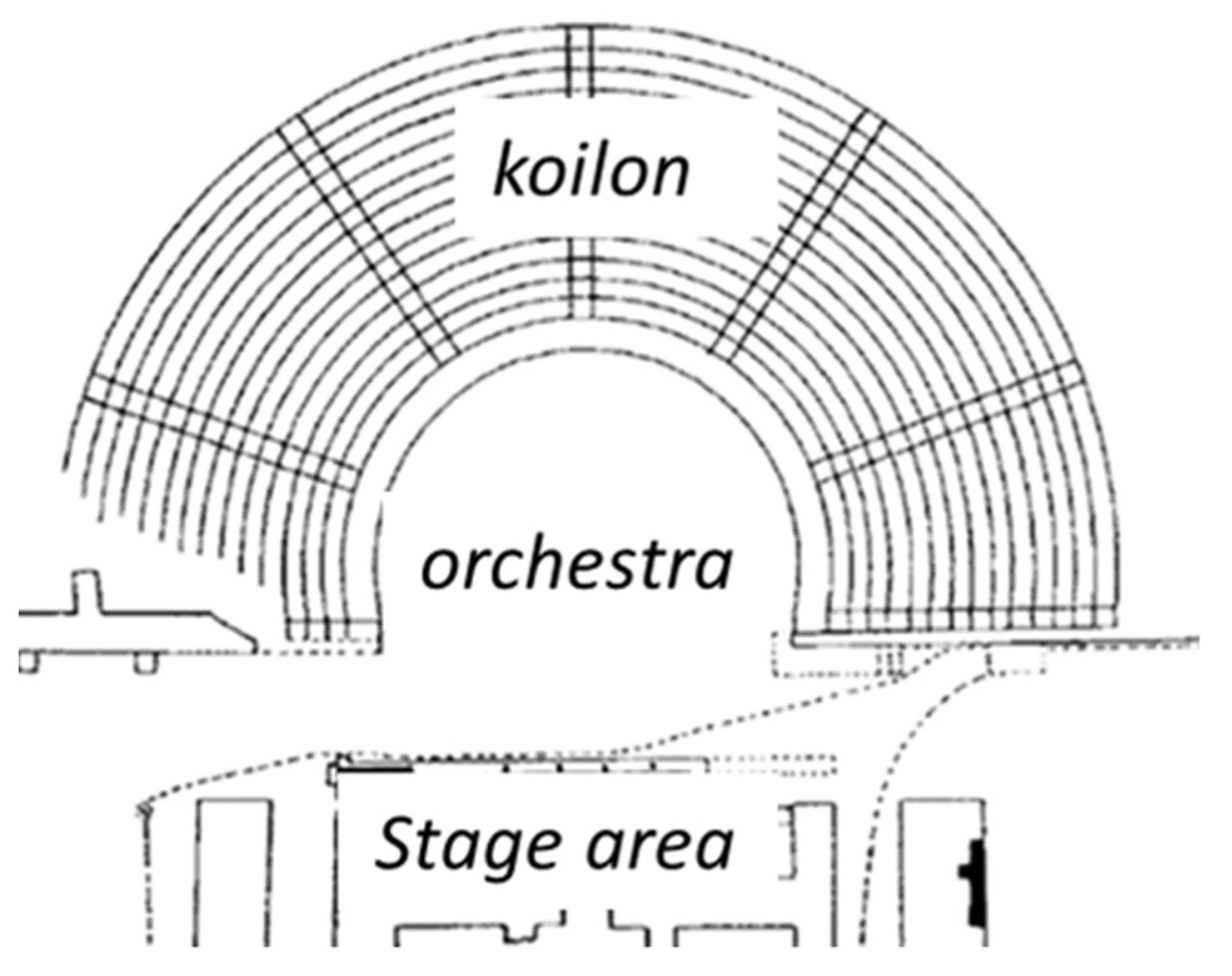
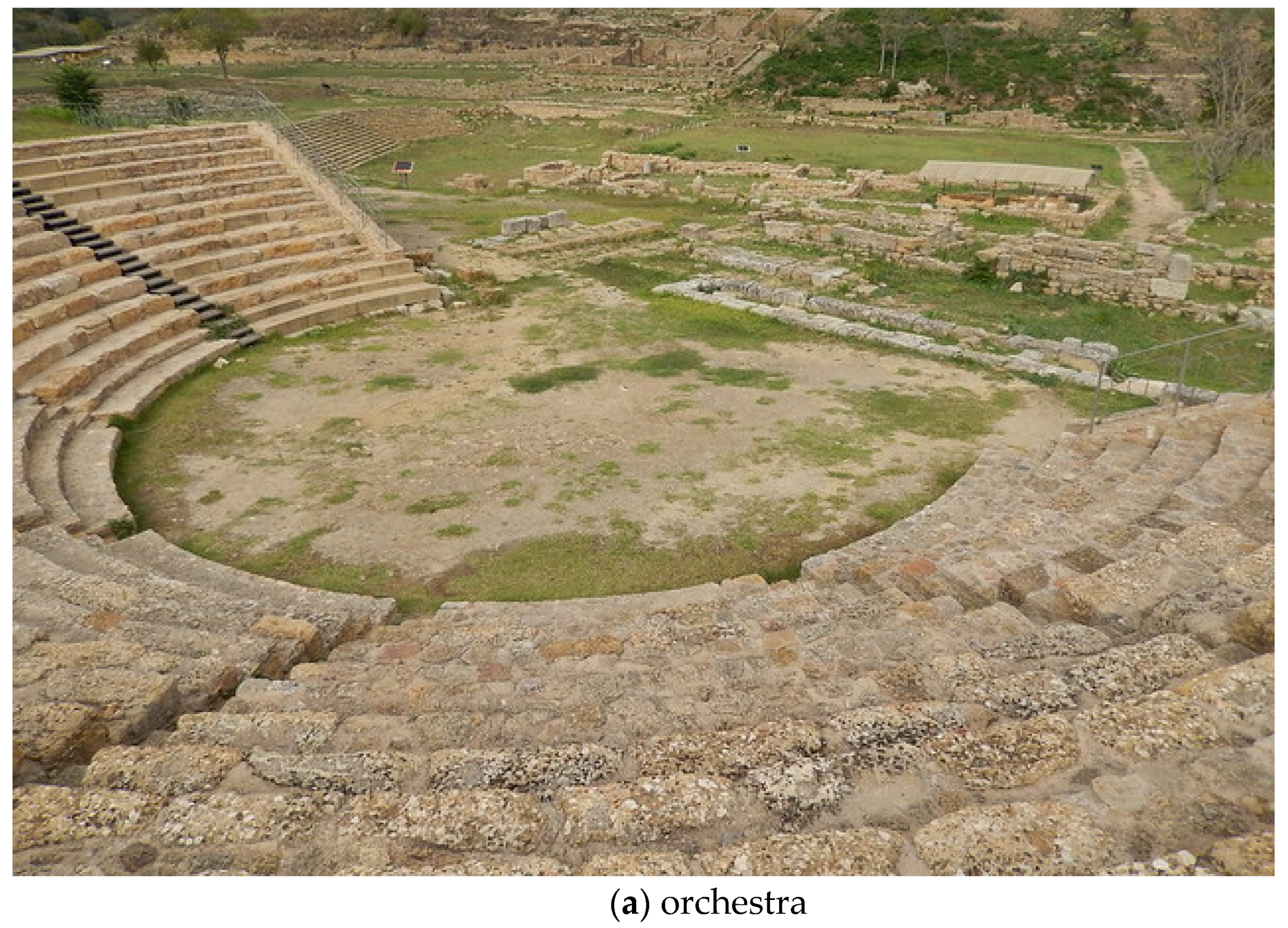
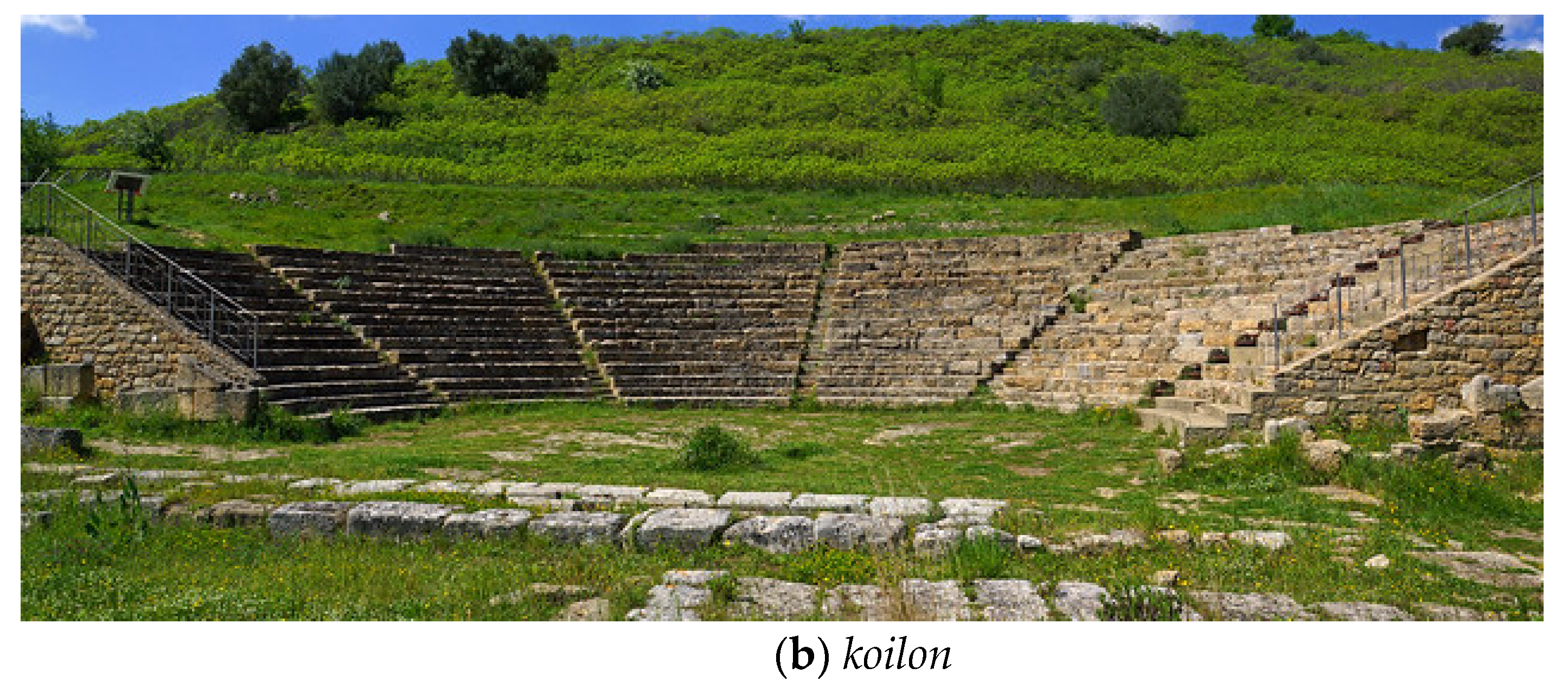
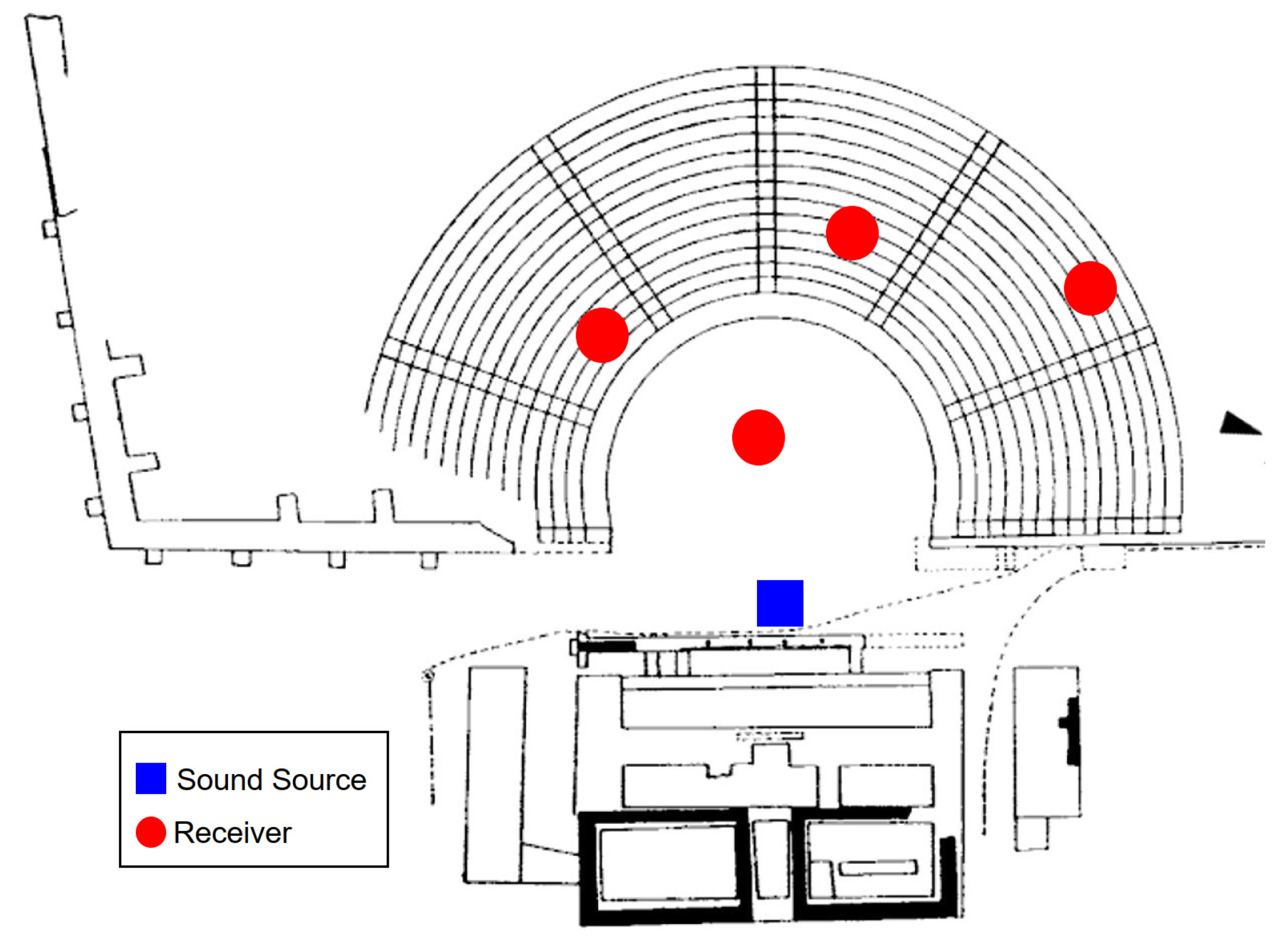
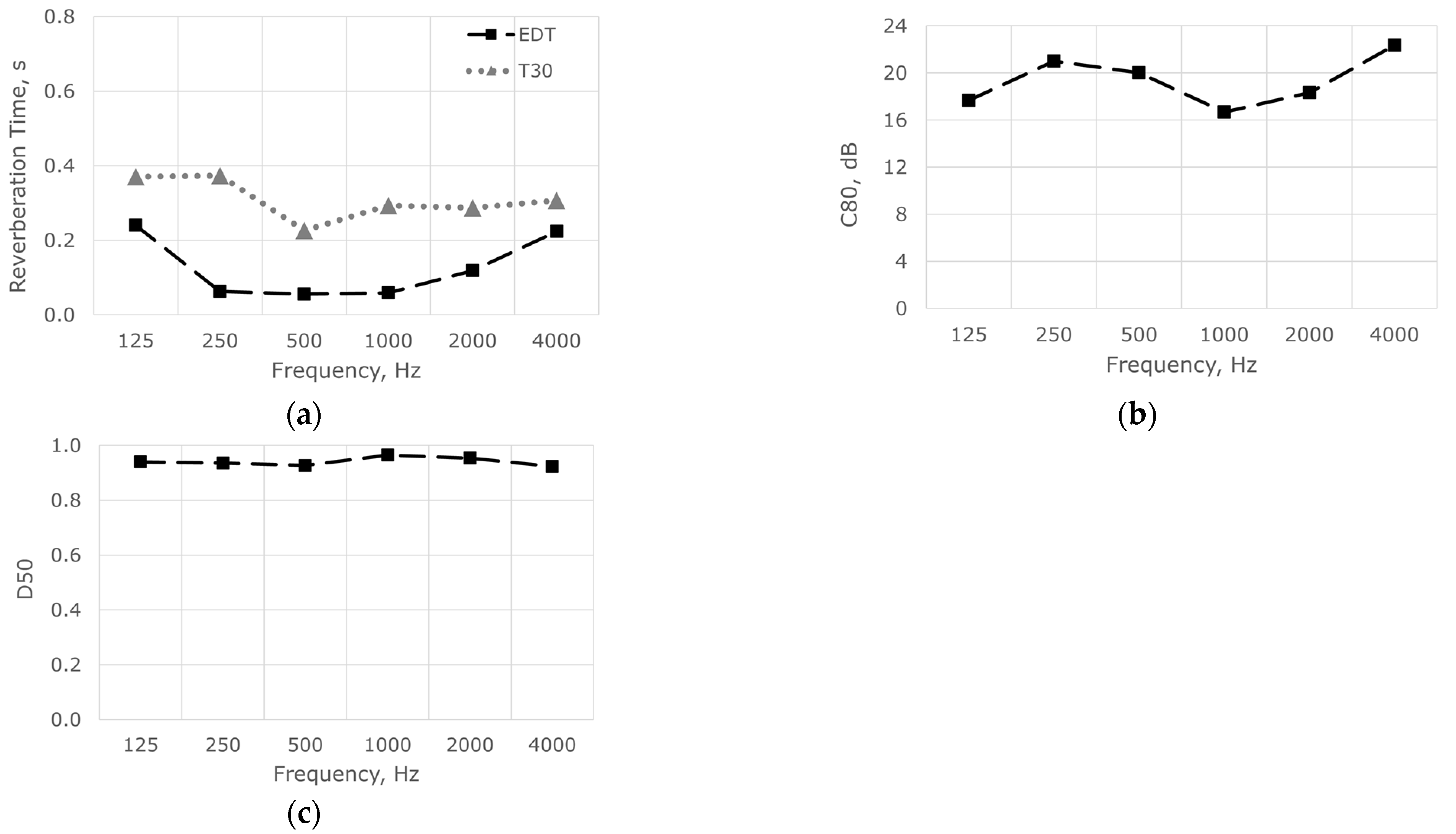
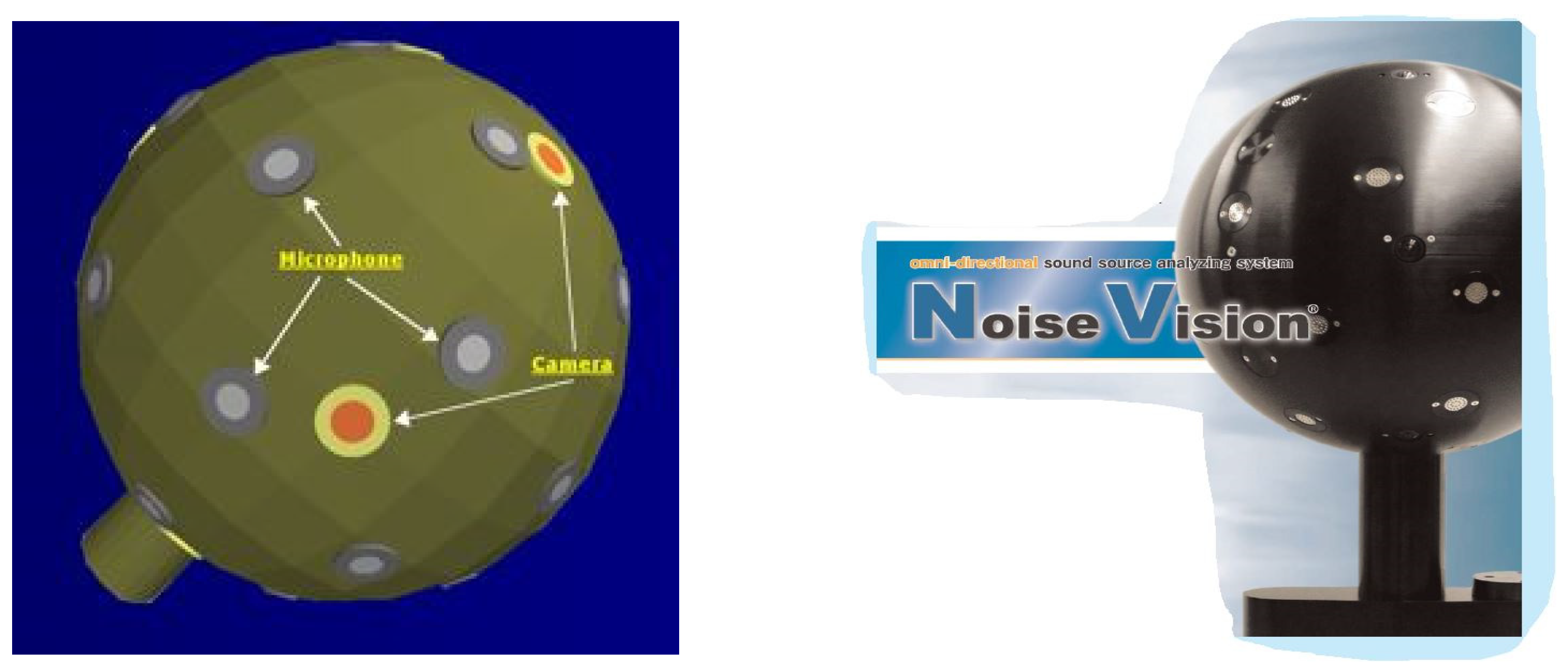
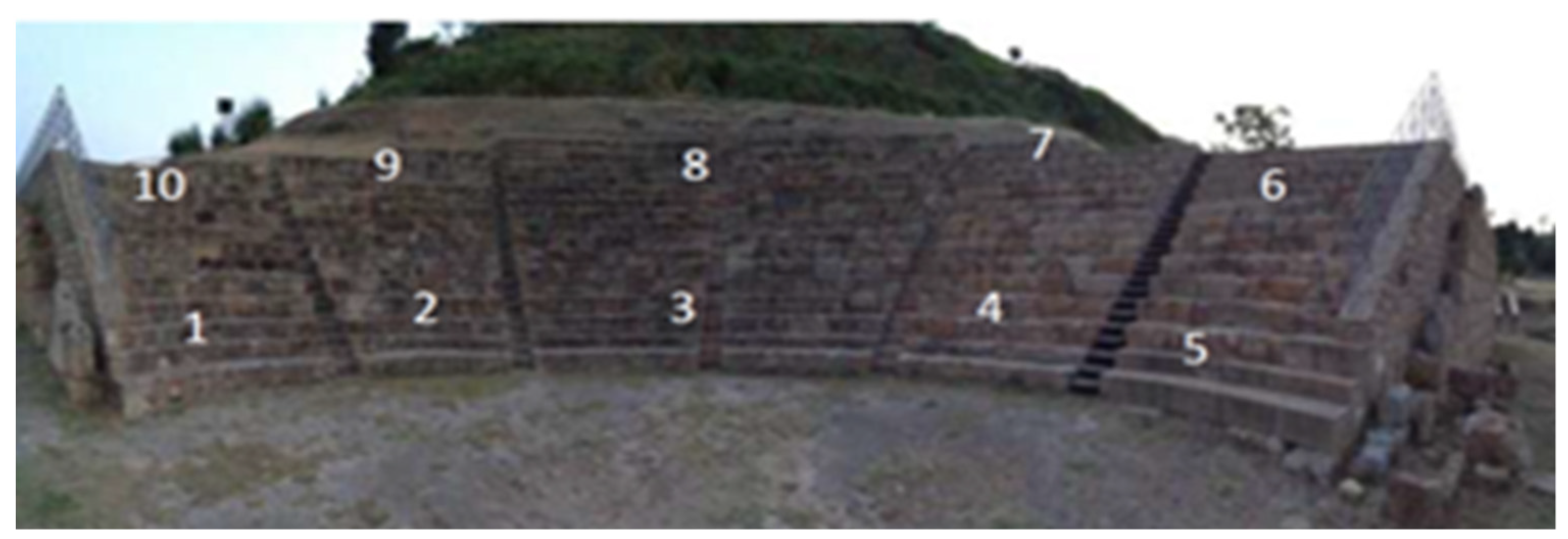
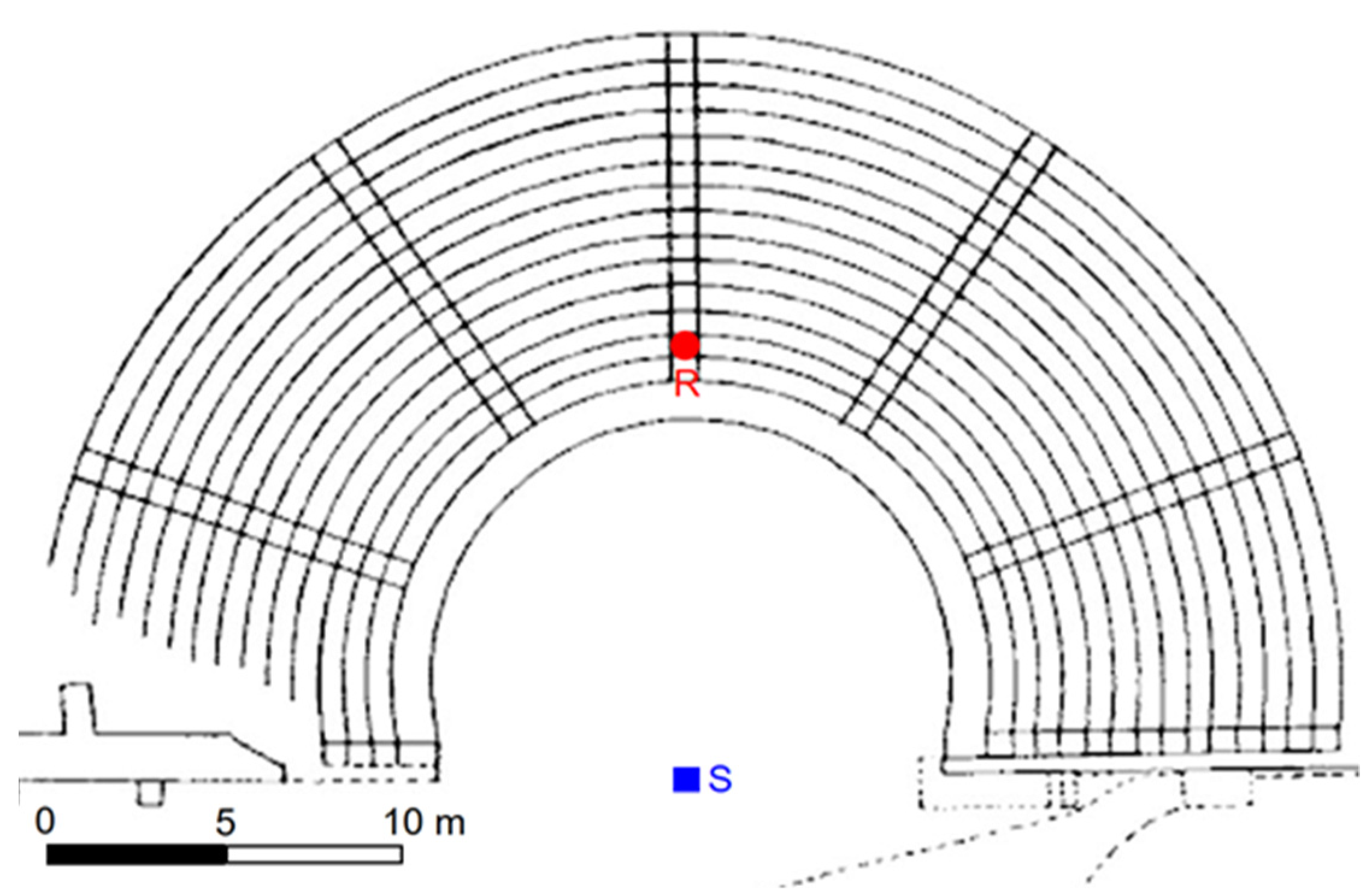
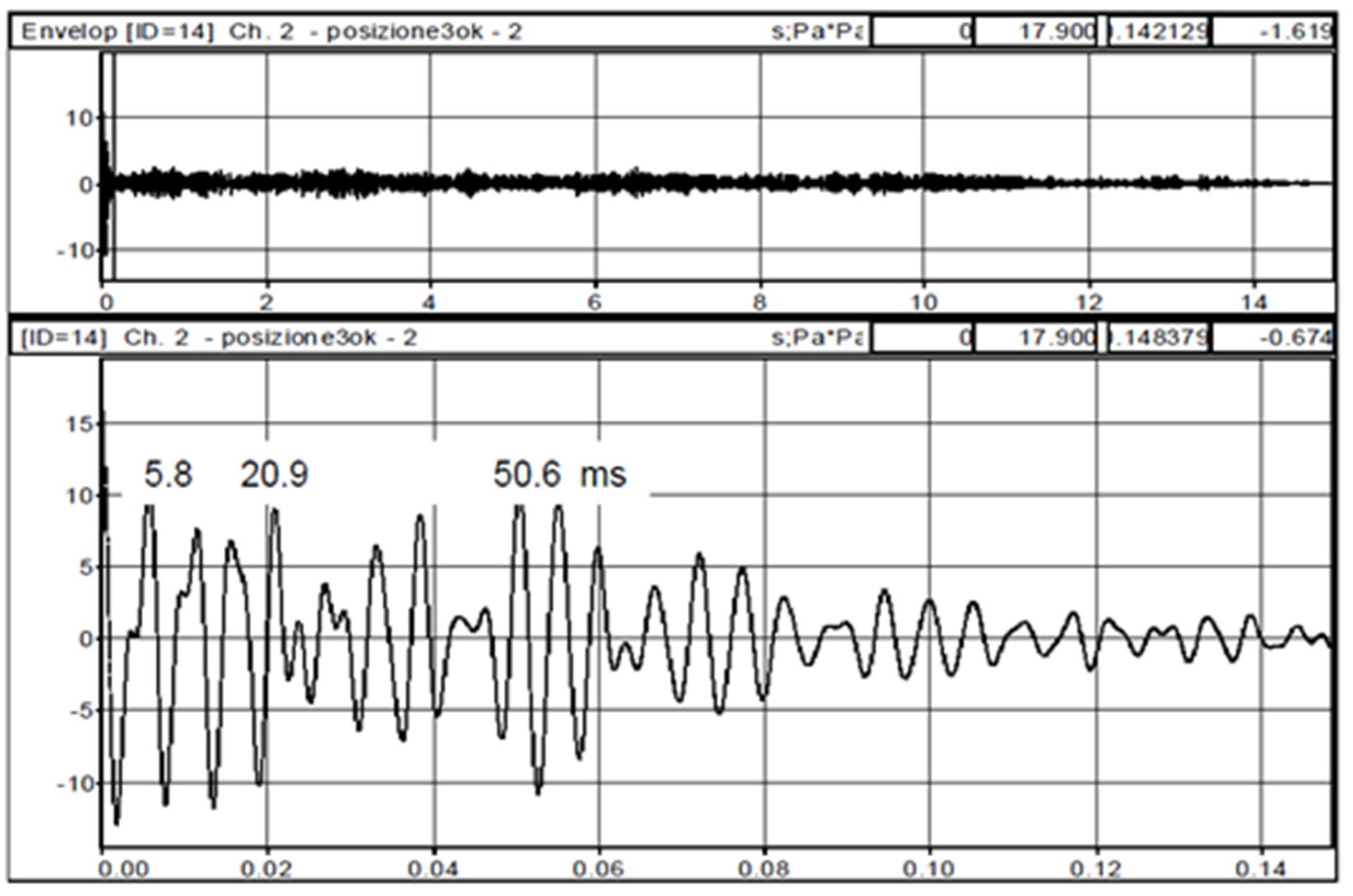
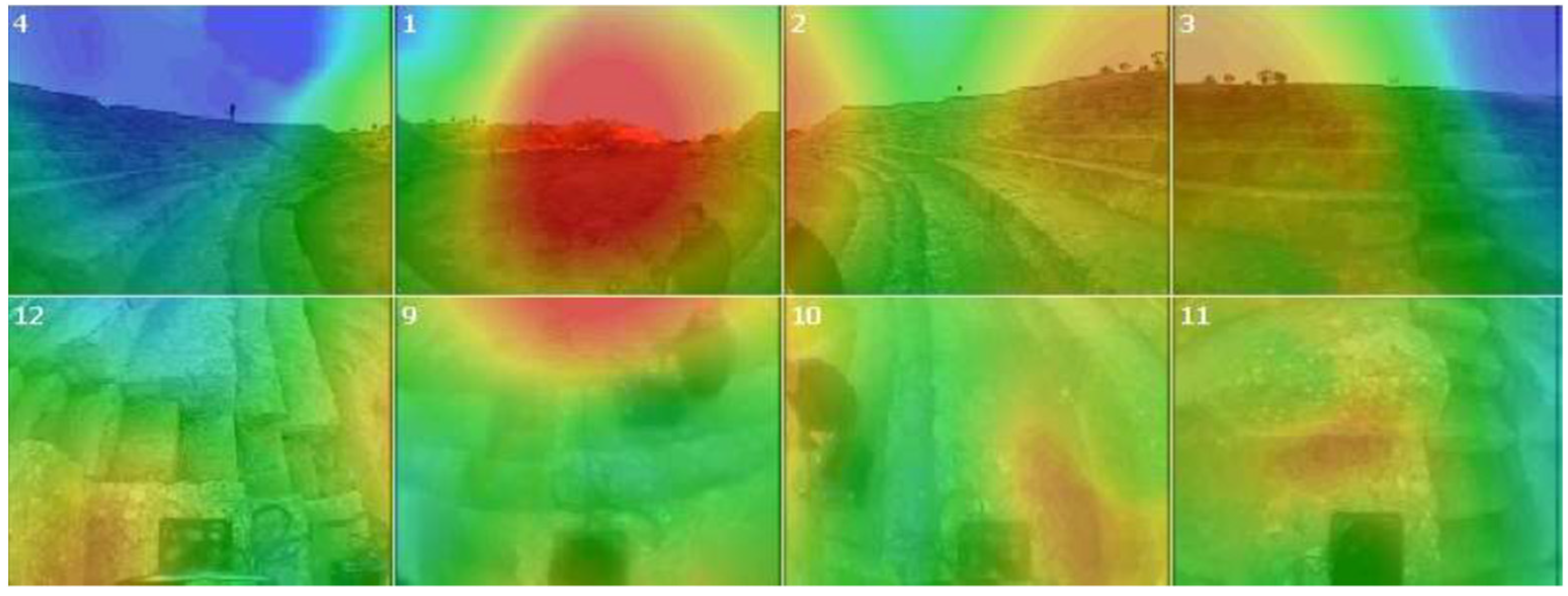
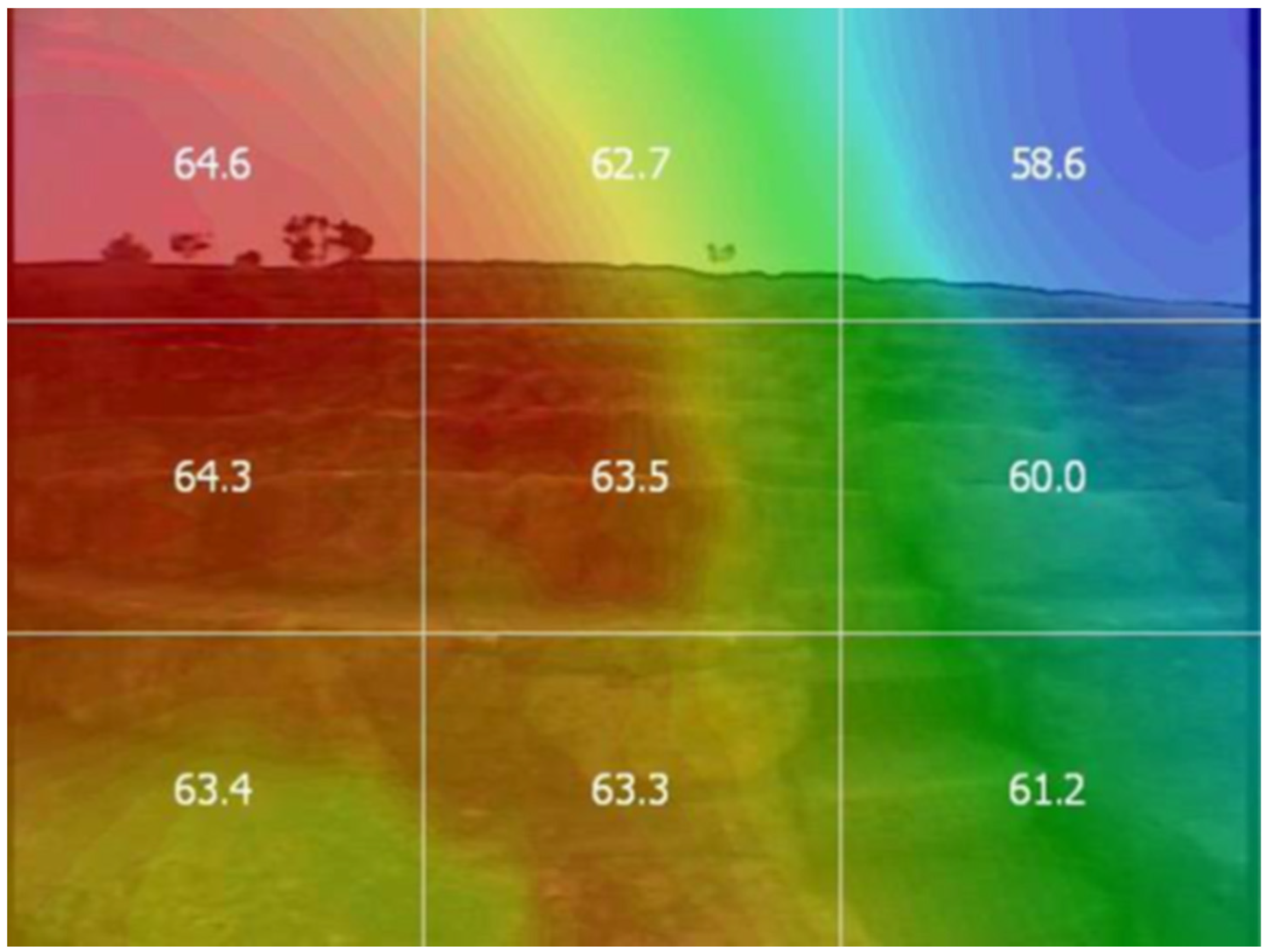
| Parameters | EDT, s | T30, s | C80, dB | D50 |
|---|---|---|---|---|
| Value for listening to the music | 1.8 < EDT < 2.6 | 1.6 < T30 < 2.2 | −2 < C80 < 2 | <0.5 |
| Value for speech comprehension | 1.0 | 0.8 < T30 < 1.2 | >2 | >0.5 |
| Theatres | T30 (s) | C80 (dB) | D50 | Cavea/Koilon Diameter (m) |
|---|---|---|---|---|
| Morgantina | 0.3 | 18 | 0.95 | 58 |
| Benevento | 0.9 | 8.0 | 0.78 | 93 |
| Cassino | 0.6 | 19.0 | 0.91 | 53 |
| Pompeii | 0.9 | 6.0 | 0.70 | 60 |
| Posillipo | 1.1 | 3.0 | 0.70 | 47 |
| Taormina | 1.9 | 1.2 | 0.53 | 110 |
| Segesta | 0.5 | 16.0 | 0.90 | 63 |
| Tyndaris | 0.55 | 18 | 0.95 | 76 |
| Siracusa | 1.2 | 13.0 | 0.90 | 140 |
Disclaimer/Publisher’s Note: The statements, opinions and data contained in all publications are solely those of the individual author(s) and contributor(s) and not of MDPI and/or the editor(s). MDPI and/or the editor(s) disclaim responsibility for any injury to people or property resulting from any ideas, methods, instructions or products referred to in the content. |
© 2023 by the authors. Licensee MDPI, Basel, Switzerland. This article is an open access article distributed under the terms and conditions of the Creative Commons Attribution (CC BY) license (https://creativecommons.org/licenses/by/4.0/).
Share and Cite
Amadasi, G.; Bevilacqua, A.; Iannace, G.; Trematerra, A. The Acoustic Characteristics of Hellenistic Morgantina Theatre in Modern Use. Acoustics 2023, 5, 870-881. https://doi.org/10.3390/acoustics5030050
Amadasi G, Bevilacqua A, Iannace G, Trematerra A. The Acoustic Characteristics of Hellenistic Morgantina Theatre in Modern Use. Acoustics. 2023; 5(3):870-881. https://doi.org/10.3390/acoustics5030050
Chicago/Turabian StyleAmadasi, Giovanni, Antonella Bevilacqua, Gino Iannace, and Amelia Trematerra. 2023. "The Acoustic Characteristics of Hellenistic Morgantina Theatre in Modern Use" Acoustics 5, no. 3: 870-881. https://doi.org/10.3390/acoustics5030050
APA StyleAmadasi, G., Bevilacqua, A., Iannace, G., & Trematerra, A. (2023). The Acoustic Characteristics of Hellenistic Morgantina Theatre in Modern Use. Acoustics, 5(3), 870-881. https://doi.org/10.3390/acoustics5030050








